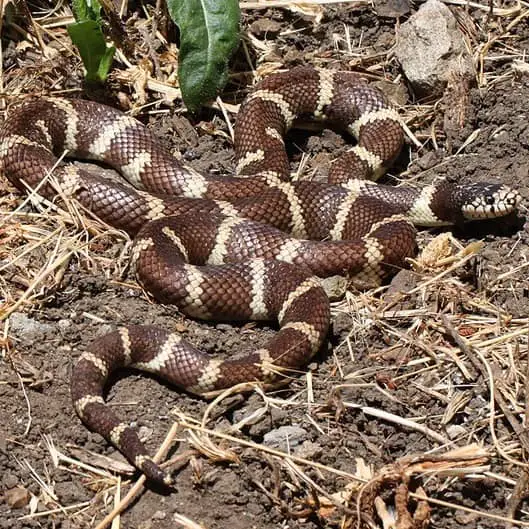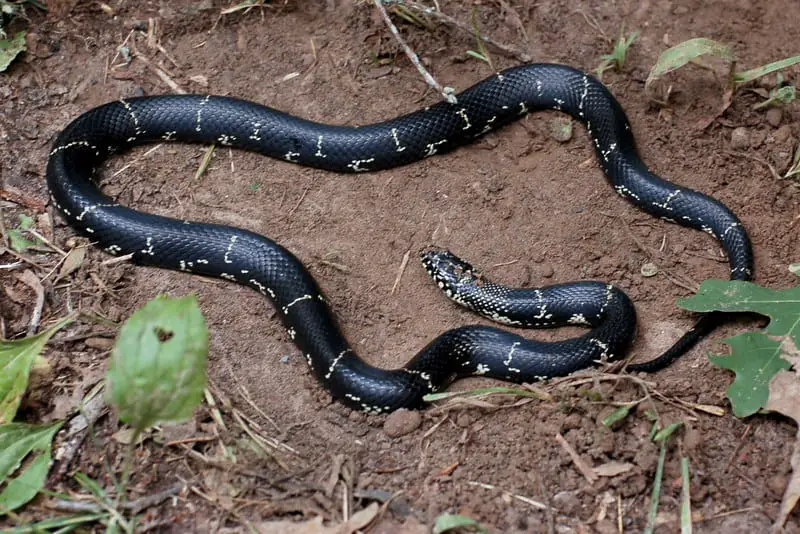The common kingsnake, also called the eastern kingnsnake, is a nonvenomous snake found in the Southeastern United States. The snake is usually black or dark brown with a wide range of yellow or cream-colored patterns. In the past, the similar-looking California kingsnake, the speckled kingsnake, the black kingsnake and the desert kingsnake have been considered a subspecies of the common kingsnake and are now all a separate species.
Description
The common (or eastern) kingsnake usually has a black or sometimes also a dark brown body coloration with various yellow, cream-colored or white patterns. The yellow patterns can either be crossbands, longitudinal lines or small spots throughout the snake’s body. Especially in speimen found in the southeast of the United States, often called Florida kingsnake, the patterns can often take on a chain-like appearance.

This snake is very slender, has a thin head and round pupils.

Size
Adult common kingsnakes can reach a total length of up to 80 inches (200 cm) with the largest ever recorded specimen measuring 82 inches (208 cm). The average elngth of an adult eastern kingsnake is around 40 inches (100 cm). They can weigh betwen 10-80 ounces (300-2,300 g), depending on their size and the amount of food and water in their system.
Former subspecies of the common kingsnake
In the past, the common kingsnake has been considered to have seven or eight subspecies. However, in 2009, four of its former subspecies have been elevated to species level. The other three remaining former subspecies are now considered to be only synomyms and geographic variations of Lampropeltis getula. Therefore, currently, there are no valid subspecies of the common kingsnake. The former subspecies that are now all part of Lampropeltis getula are:
- Lampropeltis getula floridana – Florida kingsnake
- Lampropeltis getula getula – eastern kingsnake
- Lampropeltis getula sticticeps- Outer Banks kingsnake
Four other subspecies have been elevated to species level. These are:
- Lampropeltis nigra – (eastern) black kingsnake
- Lampropeltis californiae – California kingsnake
- Lampropeltis holbrooki – speckled kingsnake
- Lampropeltis splendida – desert kingsnake
Hunting Behavior and Habitat
The common kingsnake is terrestrial, and mainly active at the beginning and end of the day (crepuscular). During the warmer months, the snake becomes nocturnal to avoid overheating.
One of the main diet items of the common kingsnake are other snakes. In addition, it also feeds on turtle eggs, lizards, amphibians and other reptiles. Its consumption of venomous snakes and especially rattlesnakes is remarkable. To limit the risk of being bitten, the king snake attacks its prey by biting and fixating its head, thus preventing it from opening its jaws. It then gradually swallows its victim while still alive. During this process, it always keeps the prey’s head constrained. Depending on its range, various types of rattlesnakes and especially copperhead and cottonmouth snakes are a favorite prey item of the common kingsnake.
The common kingsnake is highly resistant to the venom of rattlesnakes and copperhead and cottonmouth snakes. So even if they get bitten while trying to eat them, they will most likely be fine. However, a large amount of venom or a large number of intense bites can still harm and possibly kill a king snake.
They have adapted to a wide range of habitats from grasslands to farmlands, deserts and even swamps.
Bite
King snakes are nonvenomous snakes and harmless for humans. Due to their docile behavior and beautiful black and yellow color patterns, common kingsnakes are a popular pet snake.
Common king snake range in the USA
The common king snake can be found in the Southeastern United States in New Jersey, Pennsylvania, Delaware, Maryland, Virginia, West Virginia, North Carolina, South Carolina, Georgia, Florida, Alabama and Tennessee.
Scientific classification of Lampropeltis getula
- Kingdom: Animalia
- Phylum: Chordata
- Class: Reptilia
- Order: Squamata
- Suborder: Serpentes
- Family: Colubridae
- Genus: Lampropeltis
- Species: Lampropeltis getula
Other common names
In addition to common kingsnake and eastern kingsnake, Lampropeltis getula is also known under the following synomyms: Eastern black kingsnake, Florida kingsnake, chain kingsnake, Carolina kingsnake, bastard hornsnake, thunder snake, black moccasin and several more.